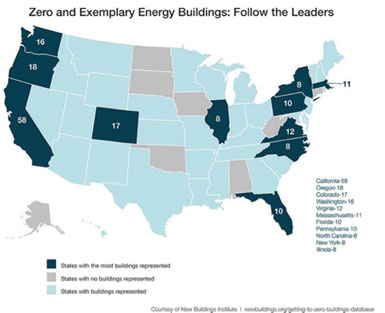In an unanimous vote, the California Energy Commission (CEC) approved energy efficiency standards for buildings that set the stage for big changes on the horizon:
In California, all new residential buildings must be net-zero energy starting in 2020, and new commercial buildings by 2030.
50% of new state buildings beginning design in 2020 must be net-zero energy, and all new state buildings and major renovations that begin design after 2025 must be net-zero energy.
Check out New Building Institute’s Getting to Zero Buildings Database:

CEC approved updates to "Title 24" that cut energy demand another 28% starting in 2017, setting the stage for net-zero energy.
New requirements are still very basic – again, showing how easy it is to reduce energy demand. Updated every three years, they rely on common sense design standards, such as "solar-ready homes" required in the last go-round.
Residential:
- Requires more insulation in walls and attic
- Requires certified energy efficient light bulbs in every socket, which cuts almost half of energy consumption from lighting
- Requires tankless water heaters that provide heated water on demand rather than storing it in a tank.
Commercial:
- Requires more insulation in walls and attic
- Requires more efficient outdoor lights and revises some indoor lighting mandates to align better with the ASHRAE 90.1-2013 national model building standard.
- Requires fans and lights to automatically shut off when elevators aren’t occupied and escalators to slow down when not in use.
- Requires buildings with operable windows to have controls that shut off heating and cooling systems when a window is open for more than 5 minutes.
Over 30 years, these standards will save energy equal to 12 big power plants! Since the 1970s, updates to Title 24 have saved Californians over $30 billion on energy bills, says CEC.
Builders can either follow specific requirements like these or choose their own methods to achieve the overall energy reduction goal.
Read our article, US Architects Move Steadily Toward Net-Zero Energy.
Read California’s Residential Zero Net Energy Action Plan:
